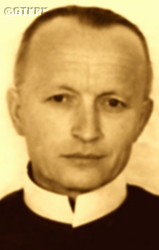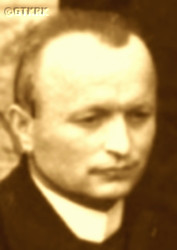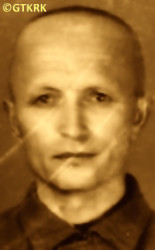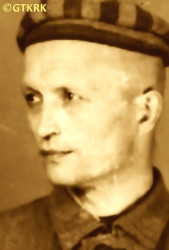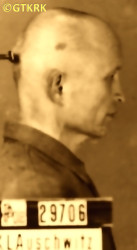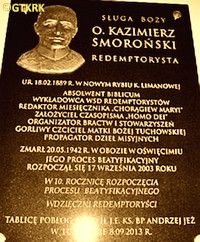Roman Catholic
St Sigismund parish
05-507 Słomczyn
85 Wiślana Str.
Konstancin deanery
Warsaw archdiocese, Poland
full list:
displayClick to display full list

searchClick to search full list by categories
wyświetlKliknij by wyświetlić pełną listę po polsku

szukajKliknij by przeszukać listę wg kategorii po polsku

Martyrology of the clergy — Poland
XX century (1914 – 1989)
personal data
religious status
Servant of God
surname
SMOROŃSKI
forename(s)
Casimir (pl. Kazimierz)
function
religious cleric
creed
Latin (Roman Catholic) Church RCmore on
en.wikipedia.org
[access: 2014.09.21]
congregation
Congregation of the Most Holy Redeemer CSsRmore on
en.wikipedia.org
[access: 2013.05.19]
(i.e. Redemptorists)
diocese / province
Polish Vice‐Province CSsR
Polish Province CSsR
RC Military Ordinariate of Polandmore on
en.wikipedia.org
[access: 2014.12.20]
academic distinctions
Bachelor of Bible Science
honorary titles
For Services to the Red Cross i.e. Germ. Verdienste um das Rote Kreuz (Austro–Hungary) — Merit 2nd Classmore on
en.wikipedia.org
[access: 2022.04.17]
(03.1916)
date and place
of death
21.05.1942

KL Auschwitzconcentration camp
today: Oświęcim, Oświęcim gm., Oświęcim pov., Lesser Poland voiv., Poland
more on
en.wikipedia.org
[access: 2022.01.09]
alt. dates and places
of death
20.05.1942, 22.05.1942
details of death
After World War I outbreak chaplain of military hospital at Schwarzenbergskaserne in Vienna (1914‐1915) — also auxiliary chaplain of the Polish units of the Austro–Hungarian Imperial Army stationed in or passing through Vienna.
After German and Russian invasion of Poland in 09.1939 and start of the World War II, after start of German occupation, co‐organizer of rescue effort of Jews in Siedliska n. Tuchów.
About the situation in the German‐run, occupied Germ. Generalgouvernement (Eng. General Governorate), informed his acquaintances, co–friars living abroad.
On 10.06.1941 survived German search of Tuchów monastery.
Warned off by the Germans — did not heed it. Finally arrested by the Germans on 16.02.1942.
Jailed in Tarnów prison.
Maltreated and tortured.
On 16.04.1942 transported to KL Auschwitz concentration camp.
There forced, along with other prisoners, to pull — running all the time — a huge roller for compacting the road.
When unable to cope, cruelly whipped inflicting bloody wounds by a German kapo.
Unconscious taken to the camp's „hospital”, where perished.
prisoner camp's numbers
29706Click to display source page (KL AuschwitzClick to display the description)
cause of death
murder
perpetrators
Germans
sites and events
KL AuschwitzClick to display the description, Regierungsbezirk KattowitzClick to display the description, TarnówClick to display the description, Help to the JewsClick to display the description, GeneralgouvernementClick to display the description, Ribbentrop‐MolotovClick to display the description, Pius XI's encyclicalsClick to display the description
date and place
of birth
18.02.1889Birth certification on:
skanoteka.genealodzy.pl
[access: 2025.08.19]

Nowe Rybietoday: Limanowa gm., Limanowa pov., Lesser Poland voiv., Poland
more on
en.wikipedia.org
[access: 2021.06.07]
parents
SMOROŃSKI John
🞲 ?, ? — 🕆 ?, ?

KAJA Marianne
🞲 ?, ? — 🕆 ?, ?
baptism
20.02.1889Birth certification on:
skanoteka.genealodzy.pl
[access: 2025.08.19]

Nowe Rybietoday: Limanowa gm., Limanowa pov., Lesser Poland voiv., Poland
more on
en.wikipedia.org
[access: 2021.06.07]
Exaltation of the Holy Cross RC church
religious vows
02.08.1906 (temporary)
presbyter (holy orders)
ordination
02.06.1911

Krakówtoday: Kraków city pov., Lesser Poland voiv., Poland
more on
en.wikipedia.org
[access: 2021.06.07]
positions held
1924 – 1942
professor — Tuchówtoday: Tuchów gm., Tarnów pov., Lesser Poland voiv., Poland
more on
en.wikipedia.org
[access: 2021.04.01] ⋄ Higher Theologica Seminary, i.e. Studentate, monastery, Redemptorists CSsR — lecturer of i.a. biblical introduction, exegesis of the Holy Scriptures, Hebrew language, history of Israel, Gregorian chant; also: head of the seminary library, chaplain, editor of the magazine „Mary’s Banner” (1927‐1933), founder and first editor‐in‐chief of the magazine „Homo Dei” (1932‐1939), national director of the League of Priestly Holiness
1923 – 1924
student — Rometoday: Rome prov., Lazio reg., Italy
more on
en.wikipedia.org
[access: 2021.12.18] ⋄ Pontifical Biblical Institute (Lat. Pontificium Institutum Biblicum), known as „Biblicum” (from 1909) — postgraduate specialised studies, on 25.06.1924 crowned with a bachelor's degree in biblical sciences on the basis of a diploma thesis Lat. „Et Spiritus Dei ferebatur super aquas. Inquisitio historic–exegetica in interpretationem textus Genesis 1,2c” (Eng. „And the Spirit of God moved over the waters. Historical–exegetical investigation into the interpretation of the text of Genesis 1,2c”), published in 1925 in „Biblica”
1921 – 1923
professor — Tuchówtoday: Tuchów gm., Tarnów pov., Lesser Poland voiv., Poland
more on
en.wikipedia.org
[access: 2021.04.01] ⋄ Higher Theologica Seminary, i.e. Studentate, monastery, Redemptorists CSsR — lecturer in biblical studies
1915 – 1921
professor — Maksymivkatoday: Vyhoda hrom., Kalush rai., Stanislaviv/Ivano‐Frankivsk obl., Ukraine
more on
uk.wikipedia.org
[access: 2022.09.02] ⋄ Higher Theologica Seminary, i.e. Studentate, monastery, Redemptorists CSsR — lecturer in biblical studies; also: socius of the students i.e. assistant to the prefect (tutor), teacher of Greek and other subjects in the last classes of the temporary Minor Theological Seminary, i.e. Juvenate
1914 – 1915
student — Viennatoday: Vienna state, Austria
more on
en.wikipedia.org
[access: 2020.07.31] ⋄ Alma Mater Rudolphina Vindobonensis (Eng. University of Vienna), i.e. Rudolphina — free attendee of lectures on the Holy Scriptures; also: chaplain of Polish academic youth in Vienna
1912 – 1914
student — Rometoday: Rome prov., Lazio reg., Italy
more on
en.wikipedia.org
[access: 2021.12.18] ⋄ Pontifical Biblical Institute (Lat. Pontificium Institutum Biblicum), known as „Biblicum” (from 1909) — in‐depth studies
1906 – 1911
student — Maksymivkatoday: Vyhoda hrom., Kalush rai., Stanislaviv/Ivano‐Frankivsk obl., Ukraine
more on
uk.wikipedia.org
[access: 2022.09.02] ⋄ Higher Theologica Seminary, i.e. Studentate, monastery, Redemptorists CSsR
1905 – 02.08.1906
novitiate — Mostyskatoday: Mostyska urban hrom., Yavoriv rai., Lviv obl., Ukraine
more on
en.wikipedia.org
[access: 2020.11.20] ⋄ monastery, Redemptorists CSsR
1905
accession — Redemptorists CSsR
1902 – 1905
pupil — Tuchówtoday: Tuchów gm., Tarnów pov., Lesser Poland voiv., Poland
more on
en.wikipedia.org
[access: 2021.04.01] ⋄ Minor Theological Seminary, i.e. Juvenate, monastery, Redemptorists CSsR
author of pamphlets, e.g. „Mother of God in the Old Testament”, Lublin 1937, numerous articles in the field of biblical studies, homiletics, ascetics and Mariology, published i.a. in „Catholic Review”
sites and events
descriptions
KL Auschwitz: German Germ. Konzentrationslager (Eng. concentration camp) KL and Germ. Vernichtungslager (Eng. extermination camp) VL Auschwitz was set up by Germans around 27.01.1940 n. Oświęcim, on the German territory (initially in Germ. Provinz Schlesien — Silesia Province; and from 1941 Germ. Provinz Oberschlesien — Upper Silesia Province). Initially mainly Poles were interned. From 1942 it became the centre for holocaust of European Jews. Part of the KL Auschwitz concentration camps’ complex was Germ. Vernichtungslager (Eng. extermination camp) VL Auschwitz II Birkenau, located not far away from the main camp. There Germans murdered likely in excess of million people, mainly Jews, in gas chambers. In KL Auschwitz alone, the Germans murdered c. 30,000 prisoners by lethal injection. Until 1941, people were killed by intravenous injections of concentrated hydrogen peroxide, ether, hydrogen peroxide, or gasoline. Later, an intracardiac injection was used — with a needle about 10 cm long — of 10‐15 ml of a 30% solution of phenol C6H5OH (acquired from the German concern IG Farben, or more precisely from its subsidiary Bayer, and still used by Bayer AG, among others, for the production of aspirin), which killed within 15 seconds. Altogether In excess of 400 priests and religious went through the KL Auschwitz, c. 40% of which were murdered (mainly Poles). (more on: en.auschwitz.org.plClick to attempt to display webpage
[access: 2012.11.23], www.meczennicy.pelplin.plClick to attempt to display webpage
[access: 2013.07.06])
Regierungsbezirk Kattowitz: After the Polish defeat in the 09.1939 campaign, which was the result of the Ribbentrop‐Molotov Pact and constituted the first stage of World War II, and the beginning of German occupation in part of Poland (in the other, eastern part of Poland, the Russian occupation began), the Germans divided the occupied Polish territory into five main regions (and a few smaller). The largest one was transformed into Germ. Generalgouvernement (Eng. General Governorate), intended exclusively for Poles and Jews and constituting part of the so‐called Germ. Großdeutschland (Eng. Greater Germany). From two separate new provinces were created. The two remaining were incorporated into existing German provinces. One of those was Polish Upper Silesia, which on 08.09.1939, by decree of the German leader Adolf Hitler (formally came into force on 26.10.1939), was incorporated into Germany as the Germ. Regierungsbezirk Kattowitz (Eng. Katowice Regency) and became part of the Germ. Provinz Schlesien (Eng. Province of Silesia) based in Wrocław. On 01.04.1940, the Germ. Regierungsbezirk Kattowitz was enlarged by several pre‐war German counties, and on 18.01.1941, a new German province was created, the Germ. Provinz Oberschlesien (Eng. Province of Upper Silesia), which, apart from the Germ. Regierungsbezirk Kattowitz, also included the Opole region. From 26.10.1939, when the regency was established, the law of the German state was in force there, the same as in Berlin. The main axis of the policy of the new regency, the territory of which the Germans recognized as the Germ. „Ursprünglich Deutsche” (Eng. „natively German”), despite the fact only 6% of its pre–war Polish part were Germans, was Germ. „Entpolonisierung” (Eng. „Depolonisation”), i.e. forced Germanization. The main mechanism was the introduction of the Germ. Deutsche Volksliste DVL, a German nationality list that was supposed to specify the national affiliation of the inhabitants of the region. The largest group marked in the compulsory registrations was Group 3, people who identified themselves as „Silesians” (in 1943 about 41%), and people remaining outside the DVL (about 36%). The latter group was intended to be deported to the Germ. Generalgouvernement (which did not happen en masse because German industry needed slave labor). Group 3, considered by the Germans as capable of Germanization, was subject to certain legal restrictions, and was subject to, among others, to conscription into the German Wehrmacht army. Children could only learn in German. A policy of terror was pursued against the Polish population. There was a special police court, controlled by the Germ. Geheime Staatspolizei (Eng. Secret State Police), i.e. the Gestapo, before which c. 4,000‐5,000 people were detained. For the years 1942‐1945 over 2,000 of them were verified, of which 1,890 were sentenced to death, including 286 in public executions. Thousands of people were murdered during the so‐called «Intelligenzaktion Schlesien», including 300‐650 Polish teachers and c. 61 Polish Catholic priests. The regency hosted a German concentration and extermination camp KL Auschwitz, where the Germans imprisoned c. 1,100,000 Jews (murdering c.1,000,000, i.e. c. 90% of them) and c. 140,000 Poles (murdering c. 70,000, i.e. c. 50% of them). After the end of hostilities of World War II, the overseer of this province, the Germ. Reichsstatthalter (Eng. Reich Governor) and the Germ. Gauleiter (Eng. district head) of the German National Socialist Party, Fritz Brecht, committed suicide. (more on: en.wikipedia.orgClick to attempt to display webpage
[access: 2024.06.24])
Tarnów: The prison commissioned on 29.11.1926, considered at that time to be the most modern of its kind in Europe. During World War II and the German occupation, it functioned under the name of Germ. Deutsche Strafanstalt Tarnów (Eng. Penal Institution Tarnów) and was initially used as a transit camp for Polish prisoners of war, and then as a prison of the German political police Gestapo. In total, the Germans held about 25,000 Poles there. Many of them were shot by the Germans in the surrounding villages, others were transported to concentration camps. Among others, on 14.06.1940, a transport of 728 prisoners, who became the first prisoners of the newly established German concentration camp KL Auschwitz, was sent from the Tarnów prison. Later, about 50 such transports were sent to KL Auschwitz, and others to KL Sachsenhausen, KL Gross Rosen, KL Ravensbruck, KL Płaszów, and the children's camp in Łódź. After the end of the military operations of World War II and the beginning of the Russian occupation, political prisoners, opponents of the Commie‐Nazi regime of the Russian republic known as prl, were also held there. (more on: www.sw.gov.plClick to attempt to display webpage
[access: 2013.08.17])
Help to the Jews: During World War II on the Polish occupied territories Germans forbid to give any support to the Jews under penalty of death. Hundreds of Polish priests and religious helped the Jews despite this official sanction. Many of them were caught and murdered.
Generalgouvernement: After the Polish defeat in the 09.1939 campaign, which was the result of the Ribbentrop‐Molotov Pact and constituted the first stage of World War II, and the beginning of German occupation in part of Poland (in the other, eastern part of Poland, the Russian occupation began), the Germans divided the occupied Polish territory into five main regions. In two of them new German provinces were created, two other were incorporated into other provinces. However, the fifth part was treated separately, and in a political sense it was supposed to recreate the German idea from 1915 (during World War I, after the defeat of the Russians in the Battle of Gorlice in 05.1915) of creating a Polish enclave within Germany. Illegal in the sense of international law, i.e. Hague Convention, and public law, managed by the Germans according to separate laws — especially established for the Polish Germ. Untermenschen (Eng. subhumans) — till the Russian offensive in 1945 it constituted part of the Germ. Großdeutschland (Eng. Greater Germany). Till 31.07.1940 formally called Germ. Generalgouvernement für die besetzten polnischen Gebiete (Eng. General Government for the occupied Polish lands) — later simply Germ. Generalgouvernement (Eng. General Governorate), as in the years 1915‐1918. From 07.1941, i.e. after the German attack on 22.06.1941 against the erstwhile ally, the Russians, it also included the Galicia district, i.e. the Polish pre‐war south‐eastern voivodeships. A special criminal law was enacted and applied to Poles and Jews, allowing for the arbitrary administration of the death penalty regardless of the age of the „perpetrator”, and sanctioning the use of collective responsibility. After the end of the military conflict of the World War UU, the government of the Germ. Generalgouvernement was recognized as a criminal organization, and its leader, governor Hans Frank, guilty of war crimes and crimes against humanity and executed. (more on: en.wikipedia.orgClick to attempt to display webpage
[access: 2024.12.13])
Ribbentrop‐Molotov: Genocidal Russian‐German alliance pact between Russian leader Joseph Stalin and German leader Adolf Hitler signed on 23.08.1939 in Moscow by respective foreign ministers, Mr. Vyacheslav Molotov for Russia and Joachim von Ribbentrop for Germany. The pact sanctioned and was the direct cause of joint Russian and German invasion of Poland and the outbreak of the World War II in 09.1939. In a political sense, the pact was an attempt to restore the status quo ante before 1914, with one exception, namely the „commercial” exchange of the so‐called „Kingdom of Poland”, which in 1914 was part of the Russian Empire, fore Eastern Galicia (today's western Ukraine), in 1914 belonging to the Austro‐Hungarian Empire. Galicia, including Lviv, was to be taken over by the Russians, the „Kingdom of Poland” — under the name of the General Governorate — Germany. The resultant „war was one of the greatest calamities and dramas of humanity in history, for two atheistic and anti‐Christian ideologies — national and international socialism — rejected God and His fifth Decalogue commandment: Thou shall not kill!” (Abp Stanislav Gądecki, 01.09.2019). The decisions taken — backed up by the betrayal of the formal allies of Poland, France and Germany, which on 12.09.1939, at a joint conference in Abbeville, decided not to provide aid to attacked Poland and not to take military action against Germany (a clear breach of treaty obligations with Poland) — were on 28.09.1939 slightly altered and made more precise when a treaty on „German‐Russian boundaries and friendship” was agreed by the same murderous signatories. One of its findings was establishment of spheres of influence in Central and Eastern Europe and in consequence IV partition of Poland. In one of its secret annexes agreed, that: „the Signatories will not tolerate on its respective territories any Polish propaganda that affects the territory of the other Side. On their respective territories they will suppress all such propaganda and inform each other of the measures taken to accomplish it”. The agreements resulted in a series of meeting between two genocidal organization representing both sides — German Gestapo and Russian NKVD when coordination of efforts to exterminate Polish intelligentsia and Polish leading classes (in Germany called «Intelligenzaktion», in Russia took the form of Katyń massacres) where discussed. Resulted in deaths of hundreds of thousands of Polish intelligentsia, including thousands of priests presented here, and tens of millions of ordinary people,. The results of this Russian‐German pact lasted till 1989 and are still in evidence even today. (more on: en.wikipedia.orgClick to attempt to display webpage
[access: 2015.09.30])
Pius XI's encyclicals: Facing the creation of two totalitarian systems in Europe, which seemed to compete with each other, though there were more similarities than contradictions between them, Pope Pius XI issued in 03.1937 (within 5 days) two encyclicals. In the „Mit brennender Sorge” (Eng. „With Burning Concern”) published on 14.03.1938, condemned the national socialism prevailing in Germany. The Pope wrote: „Whoever, following the old Germanic‐pre‐Christian beliefs, puts various impersonal fate in the place of a personal God, denies the wisdom of God and Providence […], whoever exalts earthly values: race or nation, or state, or state system, representatives of state power or other fundamental values of human society, […] and makes them the highest standard of all values, including religious ones, and idolizes them, this one […] is far from true faith in God and from a worldview corresponding to such faith”. On 19.03.1937, published „Divini Redemptoris” (Eng. „Divine Redeemer”), in which criticized Russian communism, dialectical materialism and the class struggle theory. The Pope wrote: „Communism deprives man of freedom, and therefore the spiritual basis of all life norms. It deprives the human person of all his dignity and any moral support with which he could resist the onslaught of blind passions […] This is the new gospel that Bolshevik and godless communism preaches as a message of salvation and redemption of humanity”… Pius XI demanded that the established human law be subjected to the natural law of God , recommended the implementation of the ideal of a Christian state and society, and called on Catholics to resist. Two years later, National Socialist Germany and Communist Russia came together and started World War II. (more on: www.vatican.vaClick to attempt to display webpage
[access: 2023.05.28], www.vatican.vaClick to attempt to display webpage
[access: 2023.05.28])
sources
personal:
pl.wikipedia.orgClick to attempt to display webpage
[access: 2012.12.28], www.harmeze.franciszkanie.plClick to attempt to display webpage
[access: 2012.12.28], www.ipsb.nina.gov.plClick to attempt to display webpage
[access: 2025.08.19], skanoteka.genealodzy.plClick to attempt to display webpage
[access: 2025.08.19], www.hagiographycircle.comClick to attempt to display webpage
[access: 2012.11.23], www.nowerybie.parafia.info.plClick to attempt to display webpage
[access: 2013.05.19]
original images:
prawy.plClick to attempt to display webpage
[access: 2017.11.07], www.ipsb.nina.gov.plClick to attempt to display webpage
[access: 2017.11.07], www.nowerybie.parafia.info.plClick to attempt to display webpage
[access: 2013.05.19], www.nowerybie.parafia.info.plClick to attempt to display webpage
[access: 2013.05.19], www.nowerybie.parafia.info.plClick to attempt to display webpage
[access: 2013.05.19], nitecki.wietrzykowski.netClick to attempt to display webpage
[access: 2021.04.01]
LETTER to CUSTODIAN/ADMINISTRATOR
If you have an Email client on your communicator/computer — such as Mozilla Thunderbird, Windows Mail or Microsoft Outlook, described at WikipediaPatrz:
en.wikipedia.org, among others — try the link below, please:
LETTER to CUSTODIAN/ADMINISTRATORClick and try to call your own Email client
If however you do not run such a client or the above link is not active please send an email to the Custodian/Administrator using your account — in your customary email/correspondence engine — at the following address:

giving the following as the subject:
MARTYROLOGY: SMOROŃSKI Casimir
To return to the biography press below:
 Click to return to biography
Click to return to biography








